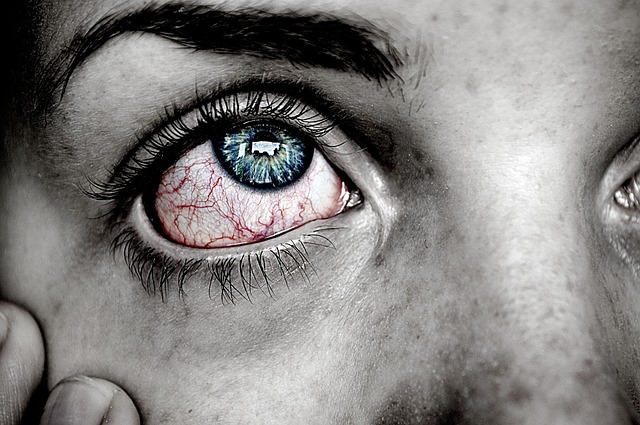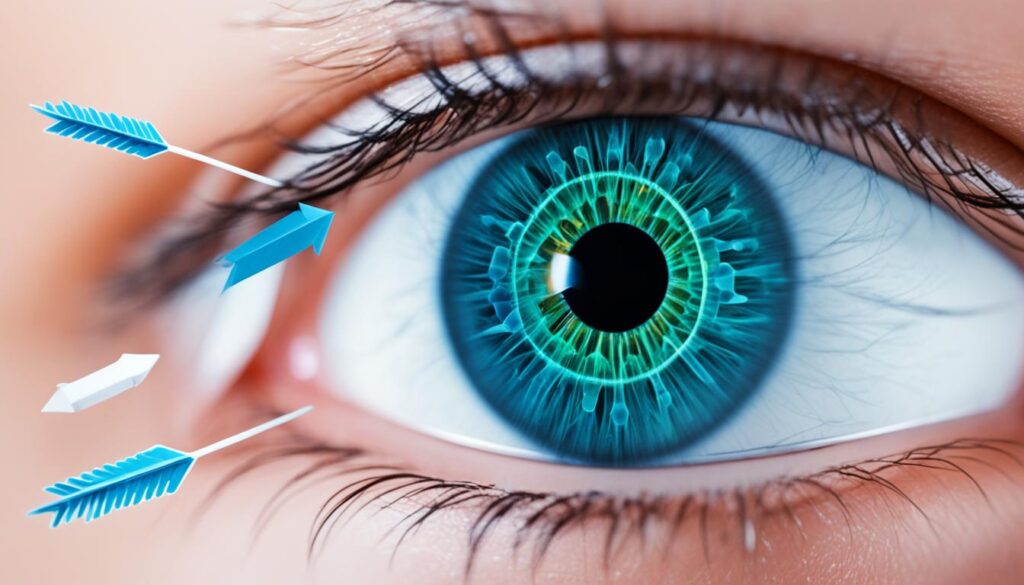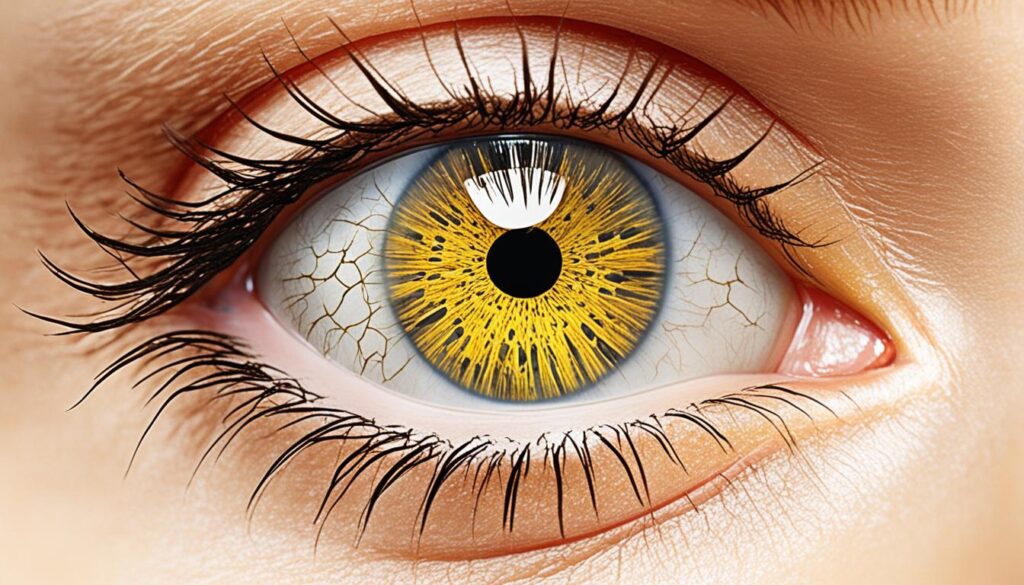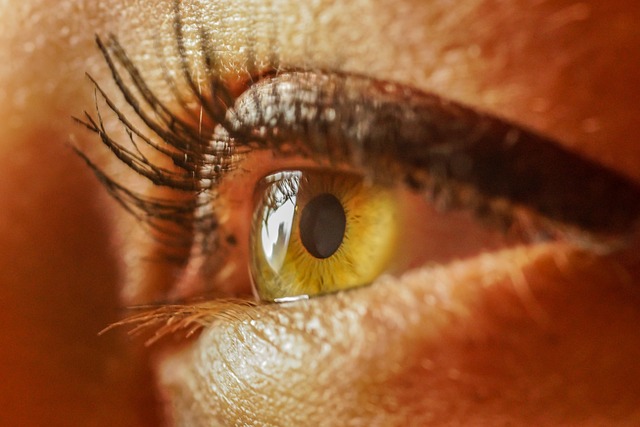
Keratoconjunctivitis Sicca AKA Dry eyes affects millions of people worldwide. This post will cover the causes, symptoms, and treatments for dry eyes. It aims to help my readers understand and manage this common eye issue.
Dry eye syndrome is eyes or tear deficiency, is a common eye condition. It happens when the eyes don’t make enough tears or when tears dry up too fast. This leads to not enough tears and an unhealthy eye surface.
Dry eye syndrome is a chronic and progressive condition. It can cause discomfort, vision problems, and harm to the eyes. It starts when not enough tear production or an imbalance in tear film composition. This imbalance is key for eye health and function.

“Dry eye syndrome is a complex and multifactorial condition that can have a significant impact on an individual’s quality of life.”
Causes of Dry Eyes
Dry eyes can come from many things, like the environment or health issues. Knowing why we don’t have enough tears is key to fixing the problem.
One big reason for dry eyes is when our tear production gets off balance. This might happen because we’re getting older, or because of pollution or dry air. Or, it could be because of Sjögren’s syndrome, a condition that attacks the glands that make tears and saliva.
- Aging: Older people often make fewer tears, which can lead to dry eyes.
- Medications: Some drugs, like antihistamines and blood pressure meds, can make dry eyes worse by reducing tear production.
- Medical conditions: Diseases like diabetes and rheumatoid arthritis can also cause dry eye and tear problems.
- Environmental factors: Wind, air conditioning, and low humidity can irritate the eyes and make dry eyes worse.
- Prolonged screen time: Looking at screens for too long can make us blink less, leading to dry eye.

Dry eyes can be really frustrating and uncomfortable. It can really affect how you live your life. The main signs of dry eyes are irritation, discomfort, and fatigue in the eyes. Knowing these signs is key to finding and treating the problem.
Common Symptoms of Dry Eyes
- Burning or stinging sensation in the eyes
- Feeling of grittiness or foreign object in the eye
- Redness and inflammation of the eyes
- Sensitivity to light and glare
- Blurred vision or difficulty focusing
- Excessive tearing, paradoxically, as the eyes try to compensate for dryness
These symptoms can vary in how bad they are and can get worse because of things like being on the computer a lot, dry air, or strong winds. If you don’t get help, dry eyes can get worse and cause bigger problems. That’s why it’s important to see a doctor.

How Hyaluronic Acid Helps Relieve Dry Eye Symptoms
When used as an eye drop, hyaluronic acid helps fix the tear film. This is key for eye health and comfort. It provides hydration that lasts, reducing irritation, redness, and discomfort from dry eyes. It also soothes the eye tissues and supports healing, helping those with dry eye symptoms.
Hyaluronic acid’s unique traits make it a top choice for treating dry eyes. By adding moisture back to the eyes, eye drops with hyaluronic acid can ease the discomfort of this common issue.
Best Hyaluronic Acid Eye Drops for Dry Eyes
Hyaluronic acid is great for dry eyes. Many eye drops use it to help with dry eyes. Let’s look at some top hyaluronic acid eye drops for relief.
Refresh Relieva Preservative-Free Lubricant Eye Drops are a top pick. They have hyaluronic acid and other ingredients to soothe dry eyes. These drops help fix the tear film and ease dry eye discomfort.
Systane Ultra Lubricant Eye Drops are also popular. They mix hyaluronic acid with moisturizers. These drops give long-lasting relief and balance the eye’s moisture.
If you need a stronger option, try Hylo-Fresh Preservative-Free Dry Eye Drops. With 0.4% hyaluronic acid, they’re great for severe dry eyes.

Complications of Untreated Dry Eyes
If dry eye syndrome is not treated, it can lead to serious problems. These problems can hurt your eye health and overall well-being. Some of these complications include:
- Corneal Damage: The cornea, which is the clear front part of the eye, can get irritated, inflamed, or even get ulcers if it’s not moisturized.
- Vision Impairment: Dry eyes that don’t go away can make your vision blurry. This makes it hard to do things like read, drive, or use digital devices.
- Eye Infections: The surface of the eye can get more likely to get infections from bacteria, viruses, or fungi. This can make the symptoms worse and lead to more serious issues.
- Chronic Discomfort: Dry eye symptoms that don’t stop can make it hard to work, sleep, or have fun.
Recognizing and treating dry eye symptoms early is key to avoiding these problems. Seeing an eye care professional can help figure out what’s causing it and how to treat it.

Diagnosing Dry Eye Disease
Diagnosing dry eye disease is key to finding the right treatment. Doctors use tests to see how bad the condition is and what causes it.
Tests and Evaluations for Dry Eyes
To diagnose dry eye, doctors do a detailed eye check-up. This might include tests like these:
- Tear Film Evaluation: Tools measure the tear film’s amount and quality. This is vital for eye health and comfort.
- Corneal Staining: Eye drops with a special dye show damage or issues on the eye’s surface.
- Meibomian Gland Evaluation: Doctors check the glands that make the tear film’s oil. They look for blockages or problems.
- Tear Osmolarity Test: This test checks the tears’ salt level. It helps understand how severe dry eye is.
- Blink Rate Evaluation: Doctors watch how often the patient blinks. Not blinking enough can cause dry eye symptoms.

Treatment Options for Dry Eyes
People with dry eye syndrome have many ways to find relief. Options range from artificial tears to prescription drugs and surgery. These methods help improve eye health and balance the tear film.
Artificial Tear Supplements
Artificial tear supplements are a common treatment for dry eyes. These drops mimic natural tears and provide quick relief. They lubricate and soothe the eyes, reducing discomfort and dryness.
Prescription Medications
For severe or ongoing dry eye, doctors may suggest prescription drugs. These can include eye drops like cyclosporine or lifitegrast to fight inflammation and boost tear production. Oral omega-3 fatty acid supplements also help with tear film health.
Surgical Interventions
Surgery might be an option for chronic or hard-to-treat dry eyes. Punctal plugs can block tear ducts to keep tears on the eye. Sometimes, surgeries like thermal pulsation or intense pulsed light therapy are used to improve tear production.

FAQ
What is dry eye syndrome?
Dry eye syndrome, also known as keratoconjunctivitis sicca, is a chronic condition. It happens when your eyes don’t make enough tears or lose them too fast. This leads to dryness, irritation, and discomfort in your eyes.
What are the common causes of dry eyes?
Many things can cause dry eyes. These include environmental factors, certain medical conditions, and some medications. Being in dry, windy, or air-conditioned places can also cause it. So can autoimmune disorders, hormonal changes, and some drugs like antihistamines and antidepressants.
What are the symptoms of dry eyes?
Dry eyes often cause irritation, burning, and stinging. You might feel like there’s grit in your eyes. You could also get tired or uncomfortable, especially after using digital screens for a long time.
